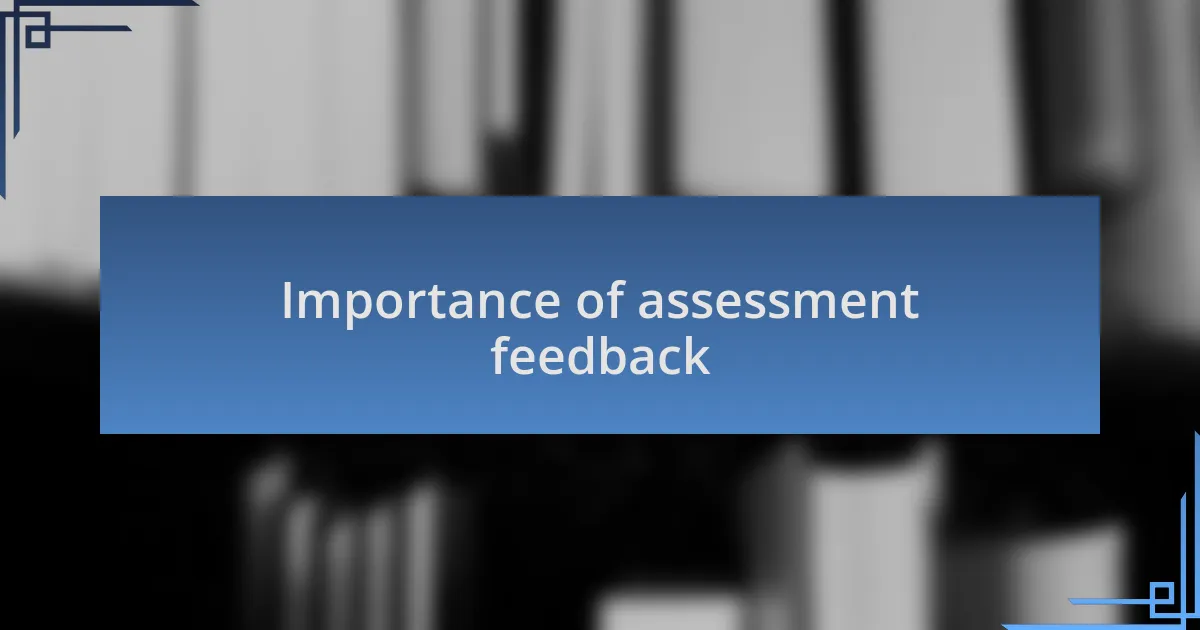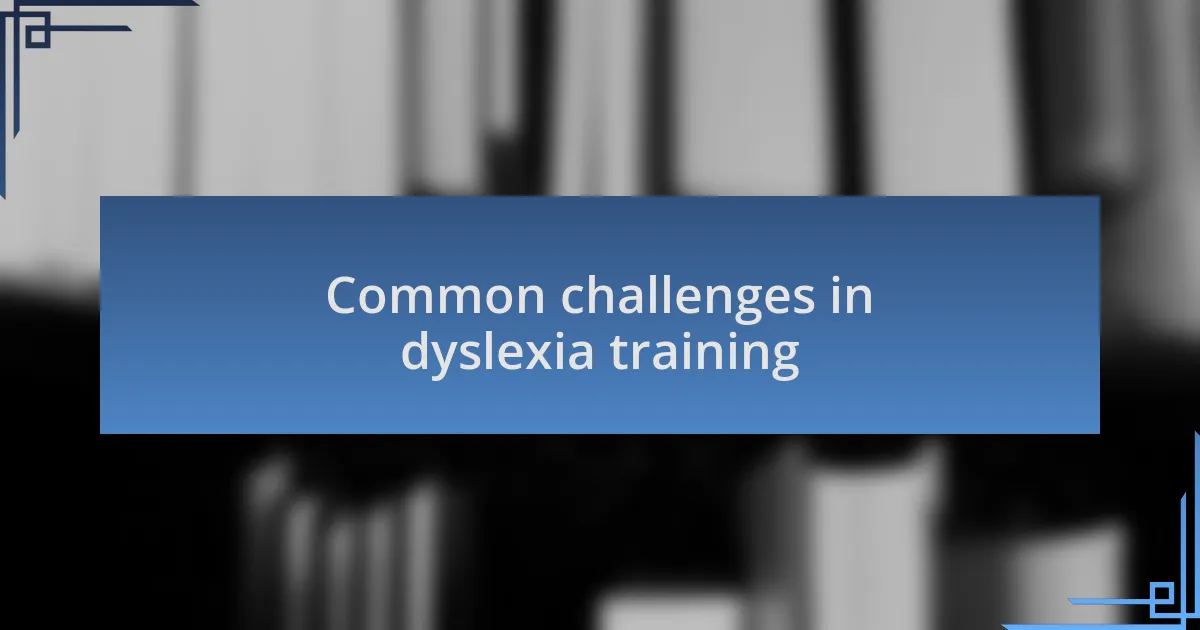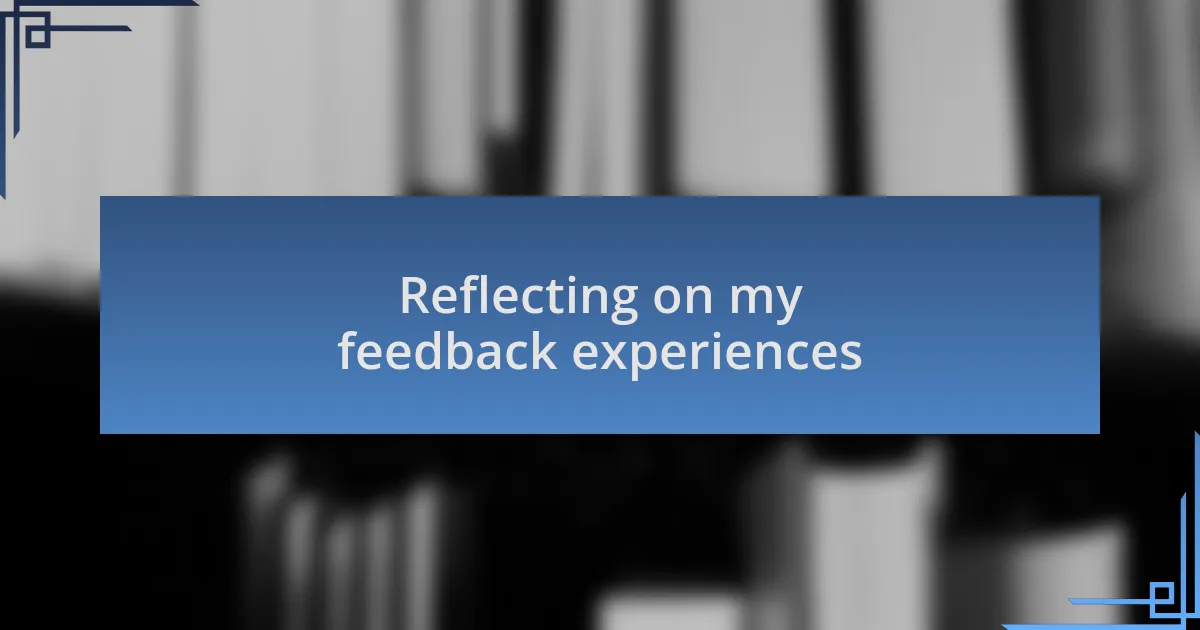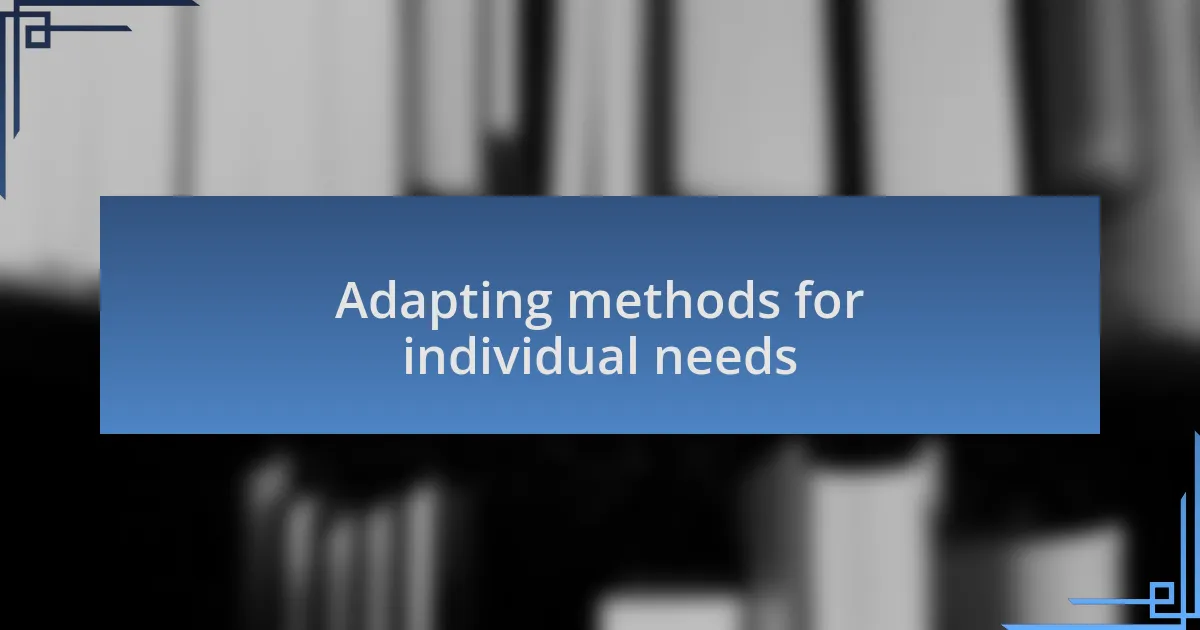Key takeaways:
- Understanding and embracing assessment feedback can transform it into a tool for personal growth, particularly for individuals with dyslexia.
- Balancing positive reinforcement with constructive criticism fosters motivation and deeper learning experiences.
- Personalizing feedback methods, such as adapting formats to individual learning styles, enhances understanding and engagement.
- Engaging in dialogue about feedback promotes clarity and encourages collaborative learning, turning potential weaknesses into strengths.

Understanding assessment feedback
Understanding assessment feedback is crucial for personal growth, especially for individuals with dyslexia. I remember receiving feedback that was initially hard to digest. Instead of seeing it as a setback, I chose to view it as a road map guiding me toward improvement. It’s essential to shift our mindset and recognize that feedback is an opportunity, not a judgment.
When I look back on my experiences, I realize that the most effective feedback often highlights my strengths alongside areas for improvement. Have you ever noticed how positive reinforcement can motivate you to tackle challenges more boldly? This balance in feedback helped me embrace my learning journey, turning what could have been discouraging moments into stepping stones for success.
Sometimes, it can feel overwhelming when presented with various suggestions for improvement. I’ve learned to take feedback one step at a time, focusing on what resonates with me rather than trying to implement everything at once. Isn’t it fascinating how a small tweak in perspective can change the entire experience? By finding clarity in the feedback I receive and breaking it down, I’ve been able to create a manageable action plan that fits my unique way of learning.

Importance of assessment feedback
Feedback is not just a formality; it’s a vital component of the learning process, especially for those of us navigating the challenges of dyslexia. I vividly remember receiving feedback on a written assignment where the emphasis was placed on my creative ideas rather than just the errors. That shift made me feel like my thoughts mattered and encouraged me to explore my writing style more freely. Have you ever felt a spark of motivation from recognizing your contributions in feedback?
The beauty of assessment feedback lies in its ability to provide targeted insights that guide our next steps. I’ve found that when feedback includes specific suggestions, it creates a clear path forward. For instance, when I was advised to focus more on structure in my writing, it wasn’t just a critique; it opened up a world of organization techniques that I still use today. How can you harness similar suggestions to fuel your growth?
Furthermore, the emotional dimensions of feedback often linger long after the initial conversation. I’ve experienced moments of vulnerability during feedback discussions, but those feelings can be transformative. Acknowledging both the anxiety and potential in receiving feedback has taught me resilience. It’s essential to remember: how often do we allow our emotions to guide us towards taking constructive steps ahead? Embracing feedback with an open heart can turn initial discomfort into a powerful catalyst for change.

Common challenges in dyslexia training
One common challenge in dyslexia training is the overwhelming amount of information presented at once. I recall attending a workshop that aimed to cover various teaching techniques in a short time. Instead of feeling empowered, I found myself lost amidst the strategies and theories. Have you ever experienced the frustration of trying to absorb too much too quickly? Narrowing the focus to a few key approaches can often lead to deeper understanding and retention.
Another issue is the reliance on traditional assessment methods that may not truly reflect an individual’s abilities. In my own journey, standardized tests often felt like a hurdle rather than an accurate measure of my skills. Reflecting on the way these assessments failed to capture my creativity and problem-solving abilities, I realized how important it is for assessments to be tailored for dyslexic learners. Isn’t it crucial that our evaluations help showcase our strengths rather than simply highlight our weaknesses?
Lastly, the emotional toll of ongoing struggles with dyslexia can be daunting. I remember the sense of defeat after continually facing challenges that seemed insurmountable. It’s a real battle when setbacks feel too frequent, making the path forward seem daunting. How do we move past those feelings of discouragement and find motivation? I’ve learned that connecting with others in similar situations often provides a sense of community and understanding that can reignite our determination to persevere.

Effective strategies for assessment feedback
Effective feedback is essential for growth, especially for dyslexic learners. I remember when I received constructive criticism on a project; it felt daunting at first, but the specific suggestions helped me refine my approach and build my confidence. Have you ever noticed how detailed feedback can illuminate blind spots and foster a stronger understanding of tasks?
Another strategy I’ve found beneficial is providing feedback in multiple formats. Personally, I appreciate when I get verbal feedback after a written evaluation or even a visual representation of where my strengths lie. This approach caters to different learning styles, making the feedback process more inclusive and easier to digest. Wouldn’t it be great if every assessment could adapt to our unique needs?
Creating a positive environment around feedback is key as well. I recall a time when my instructor celebrated small wins alongside the areas needing improvement. This balanced approach not only made the feedback feel more palatable but also motivated me to keep trying despite the challenges. How powerful is it to feel recognized for our effort while working on growth areas?

Personalizing feedback for better results
Personalizing feedback truly transforms how results are achieved. I once had a mentor who took time to understand my individual learning habits, using strategies that resonated with me. By referencing relevant examples from my own experiences, the feedback didn’t feel generic; it felt like a tailored roadmap guiding me through my challenges. Have you experienced that moment when feedback clicks because it relates directly to you?
I also value the impact of time between receiving feedback and applying it. There was a phase in my studies when I was overwhelmed with assessments. I found that discussing feedback at a later date allowed me to reflect on my understanding before diving back into the work. Isn’t it amazing how a little extra time can make feedback seem less like a barrage and more like a supportive nudge forward?
Finally, engaging in dialogue about feedback is crucial. When I approached instructors with questions about their suggestions, it deepened my insights and often led to unexpected breakthroughs in my learning. Surely, involving others in the feedback process not only clarifies our thoughts but also enhances the overall learning experience, creating a collaborative atmosphere that benefits everyone involved.

Reflecting on my feedback experiences
Reflecting on my feedback experiences has been enlightening. I recall one instance where I received constructive criticism on a writing assignment that initially felt disheartening. However, after taking a moment to breathe and truly consider the comments, I realized that the feedback highlighted areas I hadn’t even recognized myself. Isn’t it interesting how our first emotional reactions can cloud the potential for growth?
There was a time when I hesitated to even look at feedback, fearing it might showcase my weaknesses. Yet, I’ve learned to embrace this process as a vital component of my journey. With each critique, I found myself uncovering strengths I didn’t know I had. Have you ever felt that shift from dread to curiosity when engaging with feedback?
One powerful experience stands out: I once sat down with an instructor after receiving feedback to discuss it in depth. What began as a tough conversation transformed into a collaborative brainstorming session. As we peeled back layers of misunderstanding, I felt a surge of motivation to improve. It amazed me how a conversation about my weaknesses turned into a strategy session for success. When we truly engage with feedback, it can spark new ideas and perspectives, don’t you think?

Adapting methods for individual needs
Adapting methods for individual needs really highlights the importance of personalizing feedback strategies. I remember one particular tutoring session where I collaborated with a student struggling with dyslexia. Instead of focusing solely on traditional reading assessments, we decided to incorporate audiobooks and visual aids. This adjustment not only made the material more accessible but also sparked a noticeable increase in their confidence and engagement. Have you ever noticed how a simple change in approach can transform the learning experience?
When I first started working with diverse learners, I quickly realized that a one-size-fits-all approach simply wouldn’t cut it. For example, I tailored my feedback for a visual learner by using graphic organizers to map out concepts we discussed. This allowed them to visualize the feedback in a way that was meaningful and impactful. It’s fascinating how meeting learners where they are can make a difference.
I’ve also found that checking in with learners about their preferences is incredibly valuable. Just the other day, I asked a student which format they preferred for receiving feedback – verbal or written. Their response surprised me; they expressed a preference for verbal feedback in a casual setting. This not only fostered a comfortable environment but also improved their receptiveness to the suggestions. It brings to light the idea that understanding individual needs can pave the way for more effective learning experiences, don’t you think?